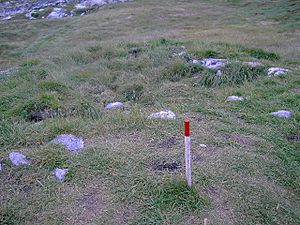Saqqaq culture facts for kids

Ancient remains of the Saqqaq culture in Sermermiut, Disko Bay, West Greenland.
|
|
| Regions with significant populations | |
|---|---|
| Southern Greenland |
The Saqqaq culture was an ancient group of people who lived in southern Greenland. They are named after the Saqqaq settlement, where many old tools and remains have been found. The Saqqaq people lived in Greenland for a very long time, longer than any other known group before them.
Contents
When Did the Saqqaq People Live?
The Saqqaq culture was the first known ancient group in southern Greenland. They lived there from about 2500 BCE (which is 4,500 years ago) until around 800 BCE. This means they were around for about 1,700 years!
During some of this time, another group called the Independence I culture lived in northern Greenland. They were there from about 2400 BCE to 1300 BCE. After the Saqqaq culture ended, new groups appeared: the Independence II culture in northern Greenland and the Early Dorset culture in West Greenland. Scientists are still discussing exactly when the Saqqaq culture changed into the Early Dorset culture in western Greenland.
The Saqqaq culture had two main periods. The newer period was different because people started using sandstone for their tools. This later Saqqaq period happened at the same time as the earliest part of the Dorset culture.
Discoveries About the Saqqaq People
Scientists found the frozen remains of a Saqqaq person in western Greenland, near Qeqertarsuaq. They called him "Inuk." By studying his DNA, they learned that he lived about 4,000 years ago. Inuk had brown eyes, black hair, and teeth that were shaped like shovels.
His DNA showed that the Saqqaq people were related to groups living in northeastern Siberia today, like the Chukchi and Koryak peoples. This means the Saqqaq people were not the ancestors of the modern Kalaallit people who live in Greenland now. Scientists are not sure if the Saqqaq people traveled to Greenland by boat or over ice.
The Saqqaq people lived in small tents. They were skilled hunters and mainly hunted seals, seabirds, and other animals from the sea. For their tools, they used strong stones like silicified slate, agate, quartzite, and rock crystals.
Saqqaq Genetics: What DNA Tells Us
A scientific study published in the journal Science in 2014 looked at the DNA of six Saqqaq individuals. These people were buried in Qeqertasussuk, Greenland, between about 3000 BCE and 1900 BCE.
The DNA samples showed that these Saqqaq people belonged to specific genetic groups called D2a1 and D2a. These same genetic groups are also common in the Dorset culture. Today, you can find these genetic groups often among the Siberian Yupik and Aleut people. This suggests that the Saqqaq people are closely related to them.
The evidence from this study suggests that the ancestors of the Saqqaq people came to North America from Siberia around 4000 BCE. They likely arrived through a separate migration. After they arrived, they mostly stayed isolated, meaning they did not mix much with other groups of people in North America.
See also
 In Spanish: Cultura Saqqaq para niños
In Spanish: Cultura Saqqaq para niños

